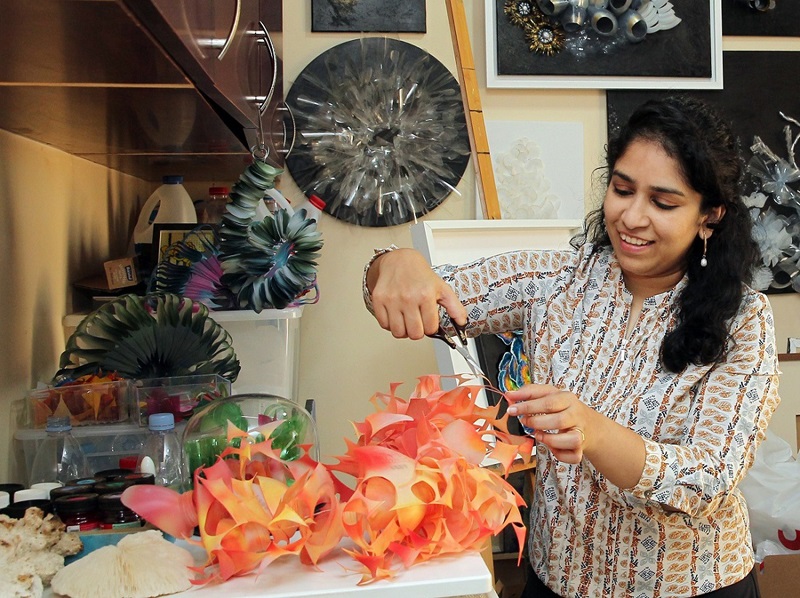
“You live in a fool's paradise if you assume that consequences of your habits will not affect us within our lifetime” claims Qatar-based artist Swapna Namboodiri through her installation made completely out of plastic bottles at M7 Msheireb.
Her first installation - Fool’s Paradise at Msheireb - uses over 1,000 single-use plastic bottles and took two weeks to complete with the help of artist friend Ooh Sinchai Zonputh, where she created a little oasis for Cutting Studio, an upcycled fashion house.

"This was commissioned work for the Studio and Ooh was contacted. Ooh works with paper and since they were looking for plastic, he suggested my name, but it was impossible for me to do it alone in such a short time span and so we did it together," says the Indian expat residing in Doha for last seven years.
A well-known artist in Qatar and world over, Swapna has exhibited her sculptures and art works at various exhibitions within the country and internationally including the Tokyo International Art Fair and Amsterdam International Art Fair before Covid struck in 2019.

Swapna found her passion through lot of hard work, research and ample amount of patience. And now every plastic piece that she gets her hand on is re-shaped, re-cut and re-designed to create art.
"I often work on many art pieces at a time so that I am able to use all parts of the plastic raw materials that I have," adds the plastic sculptor whose signature works have bright and bold colours. In fact, one section of her studio at her Al Sadd residence has plastic bottles lined up on a rack with few boxes of cut pieces in various shapes ready to turn into some exquisite work of art.

An engineer by profession, Swapna started off with painting on canvas and glass. “I was working with Infosys in Bangalore, India, when I started doing customised art pieces on wall clocks, tissue holders, candle holders and name boards. Out of curiosity, I started working with plastic and made some jewellery. Few of my customers were surprised when I informed them that the piece of jewellery they liked is plastic,” says the artist.
After relocating to Doha, Qatar, in 2014, while trying to find her niche in the art industry, Swapna continued to paint on canvas. It was in 2016 she started re-using plastic for her artwork and making sculptures.

“Every artist has to have a niche and I was trying to find mine. Since I had experimented with plastic jewellery in India, I decided to try my hand on that and thus started spending time with plastic and doing lot of trials on the material. Slowly in 2017 I made my first three sculptures - Fresh Water Pearls. I sold them and was much appreciated and thus found my signature,” says the Kerala-born engineer.

Since then, she has seen continuously cutting, mending, painting on plastic pieces preparing artworks out of them of varying sizes, usually based on the theme of nature and, particularly, ocean. A 20x30 cm piece requires 5 to 10 bottles and she prefers to work on two to three art works of same kind at a time. She has also used plastic bags as source material.
She has converted over tens of thousands of bottles into artwork and each of them can be found on her social media handles and online art galleries, all of which are updated regularly. Being an engineer and being active on social media helped her sell artworks, says Swapna, adding, “Artists, in general, feel that it is difficult to make a career out of art but then with internet in your hands that shouldn’t be the case. I am proud of the fact that I am a self-made artist who picked up nuances and different styles of art, photography, editing and even logistics to ship my works across oceans.”
A multi-tasker by nature, Swapna says that she has her hands full with her art, research, social media and, most importantly, her family that includes her husband and two kids. She is also an active member of the QatArt community at Katara, which was also her first networking base as soon as she relocated to Doha.
Swapna concludes by saying that when she started, upcycling or sustainability was not a topic, which was much discussed but working with plastic and its properties has helped her understand that the material itself is not to be blamed but the single-use mindset of individuals. And that needs to change!
